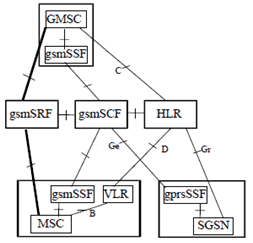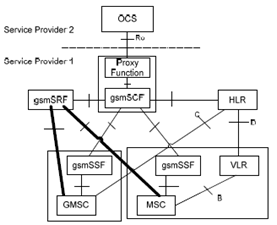Content for TS 32.276 Word version: 17.0.0
1 Scope
2 References
3 Definitions, symbols and abbreviations
3.1 Definitions
3.2 Symbols
3.3 Abbreviations
4 Architecture considerations
4.1 High level Voice Call Service (VCS) architecture
4.2 VCS charging - Offline charging architecture
4.3 VCS charging - Online charging architecture
...
...
1 Scope p. 5
The present document is part of a series of documents that specify charging functionality and charging management in GSM/UMTS networks. The GSM/UMTS core network charging architecture and principles are specified in TS 32.240, which provides an umbrella for other charging management TSs that specify:
- the content of the Charging Data Records (CDRs) per domain / subsystem / service (offline charging);
- the content of real-time charging messages per domain / subsystem / service (online charging);
- the functionality of online and offline charging for those domains / subsystems / services;
- the interfaces that are used in the charging framework to transfer the charging information (i.e. CDRs or charging events).
- The common 3GPP charging architecture is specified in TS 32.240;
- The 3GPP Diameter application that is used for VCS online charging is specified in TS 32.299.
2 References p. 5
The following documents contain provisions which, through reference in this text, constitute provisions of the present document.
- References are either specific (identified by date of publication, edition number, version number, etc.) or non-specific.
- For a specific reference, subsequent revisions do not apply.
- For a non-specific reference, the latest version applies. In the case of a reference to a 3GPP document (including a GSM document), a non-specific reference implicitly refers to the latest version of that document in the same Release as the present document.
[1]
TS 32.240: "Telecommunication management; Charging management; Charging Architecture and Principles".
[2]-[9] Void.
[10]
TS 32.250: "Telecommunication management; Charging management; Circuit Switched (CS) domain charging".
[11]
TS 32.251: "Telecommunication management; Charging management; Packet Switched (PS) domain charging".
[12]-[19] Void.
[20]
TS 32.260: "Telecommunication management; Charging management; IP Multimedia Subsystem (IMS) charging".
[21]-[29] Void.
[30]
TS 32.270: "Telecommunication management; Charging management; Multimedia Messaging Service (MMS) charging".
[31]-[49] Void.
[50]
TS 32.299: "Telecommunication management; Charging management; Diameter charging application".
[51]-[55] Void.
[56]
TS 32.293: "Telecommunication management; Charging management; Proxy Function".
[57]-[99] Void.
[100]
TR 21.905: "Vocabulary for 3GPP Specifications".
[101] Void.
[102] Void.
[103]
TS 23.002: "Network Architecture".
[104]-[199] Void.
[200]-[206] Void.
[207]
TS 23.078: "Customized Applications for Mobile network Enhanced Logic (CAMEL); Stage 2".
[208]-[211] Void.
[212]
TS 29.078: "Customized Applications for Mobile network Enhanced Logic (CAMEL); CAMEL Application Part (CAP) specification".
[213]-[233] Void.
[234]
TS 29.163: "Interworking between the IP Multimedia (IM) Core Network (CN) subsystem and Circuit Switched (CS) networks".
[232]-[297] Void.
[298]
EU Roaming regulation III; Structural Solutions; High Level Technical Specifications
[299]
EU Roaming regulation III; Interface & Protocol; Detailed Technical Specifications
[300]-[399] Void.
[400]-[499] Void.
[500]-[599] Void.
3 Definitions, symbols and abbreviations p. 7
3.1 Definitions p. 7
For the purposes of the present document, the terms and definitions given in TR 21.905 and the following apply. A term defined in the present document takes precedence over the definition of the same term, if any, in TR 21.905.
CAMEL:
network feature that provides the mechanisms to support operator specific services even when roaming outside HPLMN.
CAMEL subscription information:
identifies a subscriber as having CAMEL services.
chargeable event:
activity utilizing telecommunication network resources and related services for:
charged party:
- user to user communication (e.g. a single call, a data communication session or a short message); or
- user to network communication (e.g. service profile administration); or
- inter-network communication (e.g. transferring calls, signalling, or short messages); or
- mobility (e.g. roaming or inter-system handover); and
- that the network operator may want to charge for.
user involved in a chargeable event who has to pay parts or the whole charges of the chargeable event, or a third party paying the charges caused by one or all users involved in the chargeable event, or a network operator.
charging:
function within the telecommunications network and the associated OCS/BD components whereby information related to a chargeable event is collected, formatted, transferred and evaluated in order to make it possible to determine usage for which the charged party may be billed (offline charging) or the subscriber's account balance may be debited (online charging).
charging event:
set of charging information forwarded by the CTF towards the CDF (offline charging) or towards the OCS (online charging). Each charging event matches exactly one chargeable event.
charging function:
entity inside the core network domain, subsystem or service that is involved in charging for that domain, subsystem or service.
Circuit Switched (CS) domain:
domain within GSM / UMTS in which information is transferred in circuit switched mode.
credit control:
mechanism which directly interacts in real-time with an account and controls or monitors the charges, related to the service usage. Credit control is a process of: checking if credit is available, credit reservation, deduction of credit from the end user account when service is completed and refunding of reserved credit not used.
domain:
part of a communication network that provides network resources using a certain bearer technology.
GSM only:
qualifier indicating that this clause or paragraph applies only to a GSM system. For multi-system cases this is determined by the current serving radio access network.
in GSM,...:
qualifier indicating that this paragraph applies only to GSM System.
in UMTS,...:
qualifier indicating that this paragraph applies only to UMTS System.
"middle tier" (charging) TS:
term used for the 3GPP charging TSs that specify the domain / subsystem / service specific, online and offline, charging functionality. These are all the TSs in the numbering range from TS 32.250 to TS 32.279, e.g. TS 32.250 for the CS domain, or TS 32.270 for the MMS service. Currently, there is only one "tier 1" TS in 3GPP, which is TS 32.240 that specifies the charging architecture and principles. Finally, there are a number of top tier TSs in the 32.29x numbering range ([50] ff) that specify common charging aspects such as parameter definitions, encoding rules, the common billing domain interface or common charging applications.
online charging:
charging mechanism where charging information can affect, in real-time, the service rendered and therefore a direct interaction of the charging mechanism with bearer/session/service control is required.
Online Charging System:
the entity that performs real-time credit control. Its functionality includes transaction handling, rating, online correlation and management of subscriber account balances.
real-time:
real-time charging and billing information is to be generated, processed, and transported to a desired conclusion in less than 1 second.
successful call:
connection that reaches the communication or data transfer phase e.g. the "answered" state for speech connections. All other connection attempts are regarded as unsuccessful.
tariff period:
part of one (calendar) day during which a particular tariff is applied. Defined by the time at which the period commences (the switch-over time) and the tariff to be applied after switch-over.
tariff:
set of parameters defining the network utilisation charges for the use of a particular bearer / session / service.
UMTS only:
qualifier indicating that this clause or paragraph applies only to a UMTS system. For multi-system cases this is determined by the current serving radio access network.
voice call:
any CircuitSwitched call, whatever the teleservice used (speech, 3.1 kHz audio, Fax, or CS data) except CS video telephony calls (BS 37, 64 kbit/s unrestricted digital info mode). Voice over LTE is not included in this definition.
3.2 Symbols p. 8
For the purposes of the present document, the following symbols apply:
B
Interface between a VLR and its associated MSC(s).
C
Interface between an HLR and an MSC.
CAP
Reference point for CAMEL between a network element with integrated SSF and the OCS.
D
Interface between an HLR and a VLR.
Ge
Reference point between a gprsSSF and a gsmSCF.
Gr
Interface between an SGSN and an HLR.
Ro
Online charging reference point between a Proxy Function and the OCS.
3.3 Abbreviations p. 8
For the purposes of the present document, the abbreviations given in TR 21.905 and the following apply. An abbreviation defined in the present document takes precedence over the definition of the same abbreviation, if any, in TR 21.905.
3GPP
3rd Generation Partnership Project
CAMEL
Customized Applications for Mobile network Enhanced Logic
CAP
CAMEL Application Part
CCA
Credit Control Answer
CCR
Credit Control Request
CS
Circuit Switched
CTF
Charging Trigger Function
DCCA
Diameter Credit Control Application
DP
Detection Point
EU
European Union
GMSC
Gateway MSC
gsmSCF
GSM Service Control Function
gsmSRF
GSM Specialized Resource Function
gsmSSF
GSM Service Switching Function
GSM
Global System for Mobile communication
HLR
Home Location Register
HPLMN
Home PLMN
IMSI
International Mobile Subscriber Identity
ISDN
Integrated Services Digital Network
MF
Mobile Forwarded
MO
Mobile Originated
MS
Mobile Station
MSC
Mobile services Switching Centre
MSISDN
Mobile Station ISDN number
MT
Mobile Terminated
OCS
Online Charging System
PLMN
Public Land Mobile Network
UMTS
Universal Mobile Telecommunications System
VCS
Voice Call Service
VLR
Visitor Location Register
4 Architecture considerations p. 10
4.1 High level Voice Call Service (VCS) architecture p. 10
The high level 3G logical architecture in TS 23.002 is used for CS domain charging as in TS 32.250. Figure 4.1.1 shows the CAMEL entities as described in TS 23.002. Refer to TS 23.002 for a description of the reference points not covered in the present document.

CS domain online charging is implemented by CAMEL techniques as described in TS 23.078 and TS 29.078, i.e. outside the scope of the 32 series of charging TSs.
4.2 VCS charging - Offline charging architecture p. 10
Not specified in the present document.
4.3 VCS charging - Online charging architecture p. 10
As an alternative to direct CAMEL-based online charging of subscribers for voice calls, an online charging interface between a voice Proxy Function and the OCS is established. The concept of voice call shall be interpreted as any CS call, whatever the teleservice used (speech, 3.1 kHz audio, Fax, or CS data) except CS video telephony calls (BS 37, 64 kbit/s unrestricted digital info mode). The voice control architecture is shown in Figure 4.3.1.

Figure 4.3.1: VCS from a Proxy Function online charging architecture
(⇒ copy of original 3GPP image)
(⇒ copy of original 3GPP image)
The signalling between the CS domain elements and a voice Proxy Function is implemented by CAMEL techniques as described in TS 23.078 and TS 29.078, i.e. outside the scope of the 32 series of charging TSs. The interface between a voice Proxy Function and the OCS utilizes Diameter Ro for the voice call service online charging as specified in the present document and utilizes the Proxy Function for mapping between CAMEL and Diameter as specified in TS 32.293.